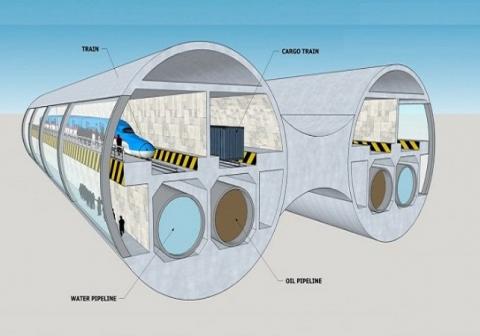
The National Advisor Bureau in the UAE has proposed a futuristic project to build a subsea rail connection to India. The Fujairah-Mumbai Subsea Tunnel Project would involve an ultra speed subsea railway, with the aim of improving the bilateral trade between the two nations.
The main expected benefits from the project are:
• Transport goods, passengers, tourists and workers between the UAE and other Gulf countries and India
• Export oil and gas from Fujairah Port to India via a pipeline, possibly China and Pakistan as well
• Import water from Narmada River, north of Mumbai, to the UAE (The Narmada River floods during monsoon season creating the opportunity for excess water to be exported to the UAE)
• Supply bunker fuel to ships passing between the floating pontoons via a floating bunker fuel station
Future expansion may include China's One Belt One Road Initiative, linking the China-Pakistan Economic Corridor at Gwadar Port with the UAE (and other Gulf countries) via Fujairah Port to complement the Chinese silk road. Future train stations could include the port city of Karachi in Pakistan and Muscat, the capital city of Oman.
Future plans may also include making provision for a road to be constructed within the floating tunnel for cars and truck transportation as well as a floating hotel, shopping centers and fuel stations in the middle of the Arabian Sea, where commuters can rest and shop.
The speed of the trains envisioned would be 600-1,000 km/h (600 miles per hour). The 1,826-kilometer (1,135-mile) distance between Mumbai and Fujairah could be covered in less than four hours, while the distance between Gawader port and Fujairah could be covered within an hour. Creating a vacuum inside the tunnel will allow for a high speed rail system as a result of reduced air resistance.
The concept of the tunnel is based on well-known technology applied to floating bridges, offshore structures and immersed tunnels, says the Bureau. The floating underwater tunnel would consist of two curved concrete tubes, submerged below the surface of the Arabian Sea. The submerged tubes would be stabilized by being attached to pontoons on the surface of the sea or by vertical tethers to the sea floor.
Provision would be made for enough gaps between the pontoons to allow ships to pass through. The tubes would be placed underwater, deep enough to avoid water traffic and weather. The tunnel would be a watertight, resistant to sea water damage and able to withstand the hydrostatic forces acting on it.
Reference: maritime-executive.com